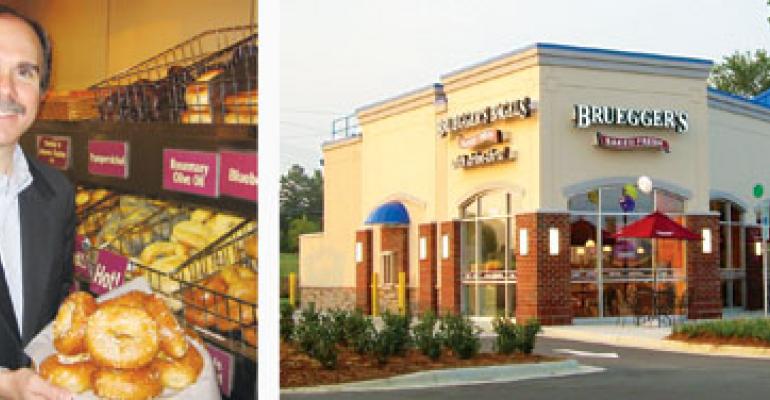James Greco, chief executive of Bruegger’s Enterprises Inc., acknowledges that the Burlington, Vt.-based Bruegger’s Bagels’ concept has had to mend a hole or two in its growth plans over the past 26 years.
However, he says, the bakery-cafe chain’s focus on guest service has helped keep the brand rolling forward even during these tough economic times.
Known as GUEST—an acronym for “Greet,” “Urgency,” “Eye contact,” “Smile” and “Thank you”—Bruegger’s evolving guest-service program effectively addresses what Greco maintains is one of the keys to surviving the downturn, customer loyalty.
“We believe this has been a big driver in the resiliency of sales, even during this economic downturn,” Greco says. “It seems logical that if you create a memorable experience, you make yourself more important to people. And if you’re important to them, it’s harder for them to cut back [on visits].”
Greco says Bruegger’s financial results bear that out. The 290-unit chain posted its 19th-consecutive quarter of positive same-store sales for the period ended December 2008, with annual systemwide sales of $200 million and an average unit volume of $730,000.
To be sure, Bruegger’s forward momentum has not always been smooth. An overly ambitious expansion strategy in the 1990s and early 2000s necessitated the closing of a number of units, stalled growth and triggered a multiyear decline in same-store sales.
But the brand has gotten back on the growth track over the past five years, and recently announced plans to open its first outlets in the New York and Chicago metropolitan areas later this year. It expects to open a total of 20 corporate and franchised outlets this year.
One pivotal element of its turnaround strategy has been its focus on guest services, with the GUEST program serving as the current centerpiece of the initiative, Greco says. The program utilizes a number of rotating elements, including training, role playing, off-site visits and reinforcement to help school its 3,500-plus employees.
For example, Greco says team members are taken to competitor’s outlets and asked to critique the experience and the store.
Bruegger’s also teamed up with beverage supplier Coca-Cola for the incentive-driven Refresh and Reward program. Individuals who have been instructed to look for certain responses or actions are sent out to the Bruegger’s locations. There, they might engage staffers in conversation or even precipitate an “accident,” like knocking over a drink and then observing how the staffer responds.
If the employee reacts in a positive way, the person sent in to evaluate staffers can present an immediate reward in the form of a gift certificate.
“It’s all about how we make guests feel,” Greco says. “We want them to feel not just welcome, but that we appreciate their being there.”
But Bruegger’s doesn’t rely exclusively on its guest services program, Greco adds. The chain also has overhauled some of its pricing strategies during these value-conscious times. For example, it launched its popular Bruegger’s Duo about a year and a half ago. The Duo lets guests choose two items from a trio of offerings that includes half a sandwich, half a soup order or half a salad for a discounted price.
BONUS POINTS “My sense is that when you’re facing a strong headwind, getting a lot of singles is a good way to win a game. Bruegger’s hasn’t had a grand slam home run, but it’s doing well on a lot of fronts. It has been improving customer ser vice, expanding the menu, enhancing catering programs and creating brand awareness. And when you’re in your fourth year of positive comps, you have to say something right is going on there.” —Dennis Lombardi, executive vice president, foodservice strategies, WD Partners, Columbus, Ohio
In addition, Bruegger’s has developed a “high-low” pricing strategy, which allows consumers to shop at either end of the pricing spectrum. “We have inexpensive breakfast sandwiches at $2.99 or lunch sandwiches at $4.99,” Greco says. “But at the same time if someone is interested in something with more ingredients or more variety, we have new paninis, priced around $6.
“It might hurt the average check and same-store sales a little, but it’s better than losing the customer altogether.”
Bruegger’s also plans to step up its marketing efforts, which includes the broadcasting of radio spots. “Last year we decided to prepare for the worst, so we budgeted extra money into marketing,” he says. “And not only for corporate. We also allocated money to our national advertising fund. For each dollar a franchisee spends for ad purposes, we match a dollar.
“We felt this was a better way to encourage people to do what is necessary.”— [email protected]
This story is from the special report, “Playing to win: Calculated moves keep skilled operators on top of their game.” To read about other restaurateurs and operators making their moves to beat the recession, you can purchase the entire report by clicking here.




